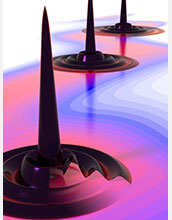Multimedia Gallery
Discovery of 'quantum droplet' in semiconductor
An artist's conception of the microscopic "quantum droplet" discovered by JILA physicists in a gallium-arsenide semiconductor excited by an ultrafast red laser pulse emitting about 100 million pulses per second. Each droplet consists of electrons and holes (representing absent electrons) arranged in a liquid-like pattern of rings. The surrounding area is plasma. The discovery--made by physicists at JILA, a joint institute at the University of Colorado Boulder, in collaboration with German theorists--adds to the understanding of how electrons interact in optoelectronic devices.
The new quasiparticle is a microscopic complex of electrons and holes in a new, unpaired arrangement. The researchers call this a "quantum droplet" because it has quantum characteristics such as well-ordered energy levels, but also has some of the characteristics of a liquid. It can have ripples, for example. It differs from a familiar liquid like water because the quantum droplet has a finite size, beyond which the association between electrons and holes disappears. Quasiparticles are composites of smaller particles that can be created inside solid materials and act together in a predictable way. A simple example is the exciton, a pairing, due to electrostatic forces, of an electron and a so-called "hole," a place in the material's energy structure where an electron could be, but isn't.
Although its lifetime is only a fleeting 25 picoseconds (trillionths of a second), the quantum droplet is stable enough for research on how light interacts with specialized forms of matter.
The discovery adds to the understanding of how electrons interact in optoelectronic devices and could have indirect benefits in terms of improving the understanding of how electrons interact in various situations, including in optoelectronic devices.
The research was supported in part by the National Science Foundation (grant PHY 11-25844).
To learn more, see the CU-Boulder news story JILA physicist discover 'quantum droplet' in semiconductor. (Date of Image: December 2013)
Credit: Brad Baxley/JILA
Images and other media in the National Science Foundation Multimedia Gallery are available for use in print and electronic material by NSF employees, members of the media, university staff, teachers and the general public. All media in the gallery are intended for personal, educational and nonprofit/non-commercial use only.
Images credited to the National Science Foundation, a federal agency, are in the public domain. The images were created by employees of the United States Government as part of their official duties or prepared by contractors as "works for hire" for NSF. You may freely use NSF-credited images and, at your discretion, credit NSF with a "Courtesy: National Science Foundation" notation.
Additional information about general usage can be found in Conditions.
Also Available:
Download the high-resolution JPG version of the image. (971 KB)
Use your mouse to right-click (Mac users may need to Ctrl-click) the link above and choose the option that will save the file or target to your computer.

